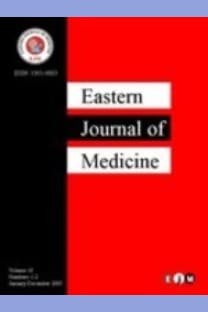Retrospective Evaluation of Term Neonatal Cases with Indirect Hyperbilirubinemia
Retrospective Evaluation of Term Neonatal Cases with Indirect Hyperbilirubinemia
___
- Daunhawer I, Kasser S, Koch G, Sieber L, Cakal H, et al. Enhanced early prediction of clinically relevant neonatal hyperbilirubinemia with machine learning. Pediatric research 2019; 86: 122-127.
- Bhutani, V. K., Johnson, L. & Sivieri, E. M. Predictive ability of a predischarge hourspecific serum bilirubin for subsequent significant hyperbilirubinemia in healthy term and near-term newborns. Pediatrics 1999; 103: 6-14.
- Bahat Ozdogan E, Mutlu M, Camlar SA, Bayramoglu G, et al. Urinary tract infections in neonates with unexplained pathological indirect hyperbilirubinemia: Prevalence and significance. Pediatr Neonatol 2018; 59: 305- 309.
- Narlı N, Satar M, Özlü F, Yapıcıoğlu H, et al. Etiological evaluation of hyperbilirubinemic neonates hospitalized in Çukurova University neonatal intensive care units. Ç.Ü.Tıp Fakültesi Dergisi 2004; 29: 1-5.
- Mahajan G, Kaushal RK, Sankhyan N,Sharma RL, et al. Transcutaneous bilirubinometer in assessment of neonatal jaundice in northern India. Indian Pediatr 2005; 42: 41 45.
- American Academy of Pediatrics Subcommittee on Hyperbilirubinemia. Management of hyperbilirubinemia in the newborn infant 35 or more weeks of gestation. Pediatrics 2004; 114: 297.
- Erdeve O, Okulu E, Olukman O, Ulubas D, et al. The Turkish Neonatal Jaundice Online Registry: A national root cause analysis. PloS one 2018; 13: e0193108.
- Phuapradit W, Chaturachinda K, Auntlamai S. Risk faktors for neonatal hyperbilirubinemia, Med Assoc Thai 1993; 76: 424-428.
- Yorulmaz, A., Yücel, M., Sert S, Özdem S, et al. Investigation of risk factors and clinical and laboratory characteristics of infants hospitalized in neonatal unit due to jaundice Journal of Contemporary Medicine 81: 7-13.
- Tan İ. Salihoğlu Ö, Demirelli Y, Hatipoğlu S. Clinical and laboratory characteristics and associated risk factors of infants hospitalized in neonatal unit due to indirect hyperbilirubinemia JCEI 2012; 3: 38-43.
- Bhutani VK, Zipursky A, Blencowe H, et al. Neonatal hyperbilirubinemia and Rhesus disease of the newborn: incidence and impairment estimates for 2010 at regional and global levels. Pediatr Res 2013; 86-100.
- Özcan M, Sevinç S, Erkan VB, Yurdugül Y, et al. Hyperbilirubinemia due to minor blood group (anti-E) incompatibility in a newborn: a case report. Turk PediatriArs 2017; 52: 162- 164.
- Agrawal A, Hussain KS, Kumar A. Minor blood group incompatibility due to blood groups other than Rh(D) leading to hemolytic disease of fetus and newborn: a need for routine antibody screening during pregnancy. Intractable & Rare Diseases Research 2020: 2019-01094.
- Roberts IA. The changing face of haemolytic disease of the newborn. Early Hum Dev. 2008; 84:515-523.
- Piazza AJ, Stoll BJ. Jaundice and hyperbilirubinemia in the newborn. In: Kliegman RM, Jenson HB, Berhman RE, Stanton BF, (eds). Nelson Textbook of Pediartics, 18th ed, Philadelphia: WB Saunders Comp 2007; 756-66.
- Kappas A, Drummond GS, Manola T, Petmezaki S, et al. Sn-protoporphyrin use in the management of hyperbilirubinemia in term newborn with direct coombs-positive ABO incompatibility. Pediatrics 1988; 8: 485-497.
- Harcke SJ, Rizzolo D, Harcke HT. G6PD deficiency: An update. Journal of the American Academy of PAs 2019; 32: 21-26.
- Eziokwu AS, Angelini D. New diagnosis of G6PD deficiency presenting as severe rhabdomyolysis. Cureus 2018; 10(3).
- Omar C, Hamza S, Bassem AM, Mariam R. Urinary tract infection and indirect hyperbilirubinemia in newborns. N Am J Med Sci 2011; 3: 544-547.
- Shahian M, Rashtian P, Kalani M. Unexplained neonatal jaundice as an early diagnostic sign of urinary tract infection. Int J Infect Dis 2012; 16: 487-490.
- Bilgen H, Ozek E, Unver T, Biyikli N, et al. Urinary tract infection and hyperbilirubinemia. Turk J Pediatr 2006; 48: 51-55.
- Bratlid D, Nakstad B, Hansen TW. National guidelines for treatment of jaundice in the newborn. Acta Paediatr 2011; 100: 499-505.
- Zahed Pasha, Y., Alizadeh-Tabari, S., Zahed Pasha, E. et al.Etiology and therapeutic management of neonatal jaundice in Iran: a systematic review and meta-analysis. World J Pediatr (2020).
- Sgro M, Campbell D, Shah V. Incidence and causes of severe neonatal hyperbilirubinemia in Canada. CMAJ 2006; 175: 587-590.
- Ives NK. Management of neonatal jaundice. Paediatr Child Health 2011; 21: 270-276.
- Kim MS, Chung Y, Kim H, Ko DH, et al. Neonatal exchange transfusion: Experience in Korea. Transfusion and Apheresis Science 2020: 102730.
- ISSN: 1301-0883
- Yayın Aralığı: 4
- Başlangıç: 1996
- Yayıncı: ERBİL KARAMAN
Resul NUSRETOĞLU, Hakan SARSILMAZ, Yunus DÖNER
Ramazan Sami AKTAŞ, Gizem GİZLİ, Sevdegül Karadaş BİLVANİSİ, Mehmet Reşit ÖNCÜ, Mesut IŞIK
Kamil YAVUZER, Beyza YAVUZER, Emin OĞUZ, Guner KILIÇ, Yusuf KAYAR, Serap TAŞ
Suzan GÜVEN, İsmail MERAL, Mertihan KURDOĞLU, Halit DEMİR
The Effects of Rutaecarpine on Metastatic Prostate Cancer Cells
Mehmet Abuldukadir ŞEKEROĞLU, Erdem ÇOKLUK, Mehmet Ramazan ŞEKEROĞLU, Fatma Betül TUNCER, Zeynep ÖZMAN, Gamze Güney ESKİLER
Comparison of Short-Term Outcome of Late Preterm and Term Infants
Ayten BEYAR, Esin ALDEMİR, Müge PAYASLI, Sultan KAVUNCUOĞLU, Mehmet Gökhan RAMOĞLU, Serdar SANDER
Reyhan GÜNDÜZ, Elif AĞAÇAYAK, Dicle Akkılıç DÖNMEZ, Fatih Mehmet FINDIK, Mehmet Sıddık EVSEN, Talip GÜL
Özge Yücel ÇELİK, Mehmet OBUT, Gülşah DAĞDEVİREN, Ayşe KELEŞ, Neval Çayönü KAHRAMAN, Gülşah Aynaoğlu YILDIZ, Özgür ARAT, Cantekin İSKENDER
Retrospective Evaluation of Term Neonatal Cases with Indirect Hyperbilirubinemia
Rezzan Ezgi EKİN, Sabahattin ERTUĞRUL, İbrahim DEĞER, İlyas YOLBAŞ
